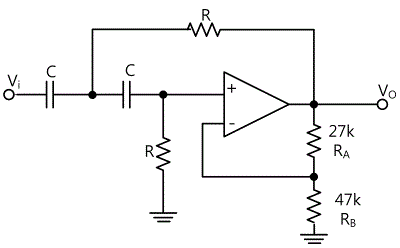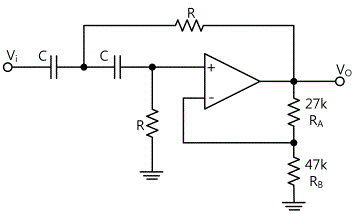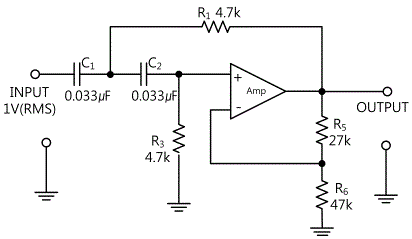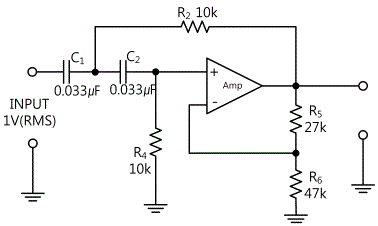PART9Active Filter Circuit
Experiment 2 :High-Pass Filter
Theory
As in fig. 9-6, VCVS high pass filter is the circuit in which the location of resistance and condenser is changed in equivalent VCVS low pass filter, and its pass band gain or the cutoff frequency is same as that of low pass filter.

The pass band gain is 1.586, that is, +4dB.
Experiment Process
1. In Circuit-2 of M-09, make the both ends of 2c-2d, 2f-2g shorted and compose a circuit as in fig. 9-7.
2. Apply the input of 1V(rms) to the both ends of 2a-2b. Change the frequency as given in table 9-2 and measure the output voltage and record it in the relevant column.
3. This time, make the 2c-2e, 2f-2h terminals shorted and compose a circuit as in fig. 9-8.
4. Apply the input of 1V(rms) and use the frequency given in table 9-2 to measure the output voltage and record it.
5. Draw a graph in the experiment result report using the measured value.
tab1Experiment 9-2.1 High Pass Filter experiment (In Circuit-2 of M09, compose circuits as in fig. 9-7 and fig. 9-8.)
1.Connection(Circuit-1 of M09), Fig. 9-7 HPF Circuit(a)
1.Circuit Connection
Resistance R1, R3 Connection; Connect between 2c terminal and 2d terminal, between 2f terminal and 2g terminal of Circuit-2 with yellow lines.
2.Power Connection
It is connected internally.
3.Measuring Instrument Connection
Function Generator Connection
Plug in BNC cable to BNC terminal of Signal Output on front panel and connect red line to 2a terminal of Circuit-2, and black line to 2b terminal.
Voltmeter Connection
Input Voltage Measurement Connection: - Connect between 2a terminal of Circuit-2 and A+ terminal of Signal Input CH A on the front panel of Multimeter with red line, and between 2b terminal and A- terminal with black line.
Output Voltage Measurement Connection: Connect between 2i terminal of Circuit-2 and B+ terminal of Signal Input CH B on the front panel of Multimeter with red line, and between 2j terminal and B- terminal with black line.
2.Wiring Diagram
3.Measurement
- 1Choose analog output at Touch LCD panel, click Function Generator and set up Amplitude Range as , and click of Amplitude and set up as amplitude 15%.
Set up Signal as , and choose at Frequency and click to set up as frequency 200.Click and apply the output of Function Generator to input of Circuit-2.
Changing 1V(rms) as Vpp can be done by the formula below.
VPP=Vrms×2√2=1V×2×1.414=2.83VPP
The 15% of 20Vpp set up above is 3.0Vpp so it is set up as the approximation of 1V(rms).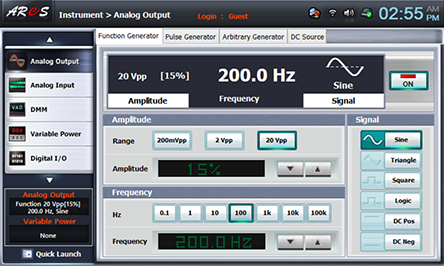
- 2Measurement
Choose analog input at front panel, choose Volt & Ampere Meter tab and click , , at CH A, CH B and record the output voltage measured at CH B in the relevant column of table 9-2.

Choose quick launch on the left bottom of the screen, click Analog Output and click of Frequency at Function to change the frequency as in table 9-2. Record the measured output voltage in the relevant column of table 9-2.
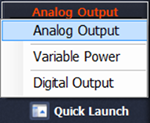
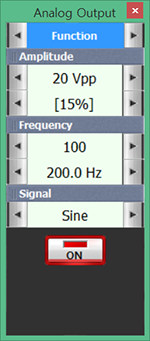

After the measurement, click at quick launch screen and cut off the output.
- 3Fig. 9-8 HPF Circuit(b) Experiment
Resistance R2, R4 Connection: Change the connection between R1 and R3 to between 2c terminal and 2e terminal, and between 2f terminal and 2h terminal of Circuit-2 and connect with yellow lines.
Wiring Diagram
Execute as the process 2) above and record the result in the relevant column of table 9-2.


After the measurement, click at quick launch screen and cut off the output.
4.Calculation
1. Calculate the cutoff frequency when connecting resistance R1 and R3, and .when connecting resistance R2 and R4.

If making R1 and R2 same, and C1 and C2 same, the cutoff frequency is as below.

Experiment Result Report
1. Experiment Result Table
2. Review and Explanation
1) Using the measured result in table 9-2, draw the characteristic curve in the graph.
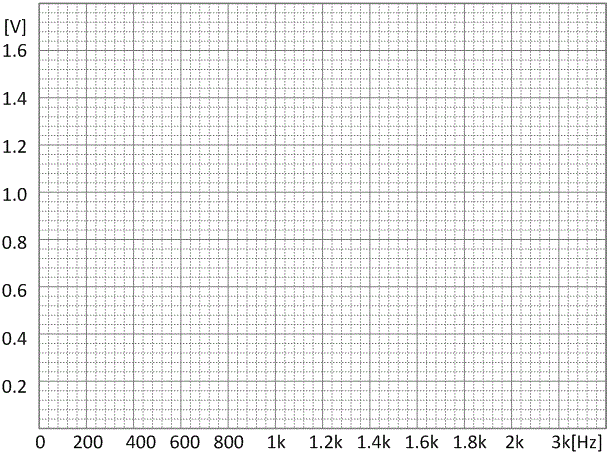 Characteristic of Active Filter(HPF)
Characteristic of Active Filter(HPF)
2) Using the figure and formula below, calculate the amplification degree Av, Q, cutoff frequency and 3dB frequency of circuit 9-7, 9-8. (When Q=0.699, Kc =1, K3=1)

